New

Turn Your DMs Into Lead Gen!
Learn how to collect lead data from your DMs such as email addresses, phone numbers, and more right from your social inbox. If you are not yet automating your DMs your competitors are outpacing you.

How Something Social Saved 75% of Their Time and Increased Revenue by 15%
See how a fast-growing agency improved operations, cut down hours of manual work, and unlocked new revenue opportunities with Vista Social.
New

50 Unique Social Media Ideas for Consistent Content Creation
Discover 50 unique social media post ideas to engage your audience, grow your brand, and maintain a consistent content strategy with ease!
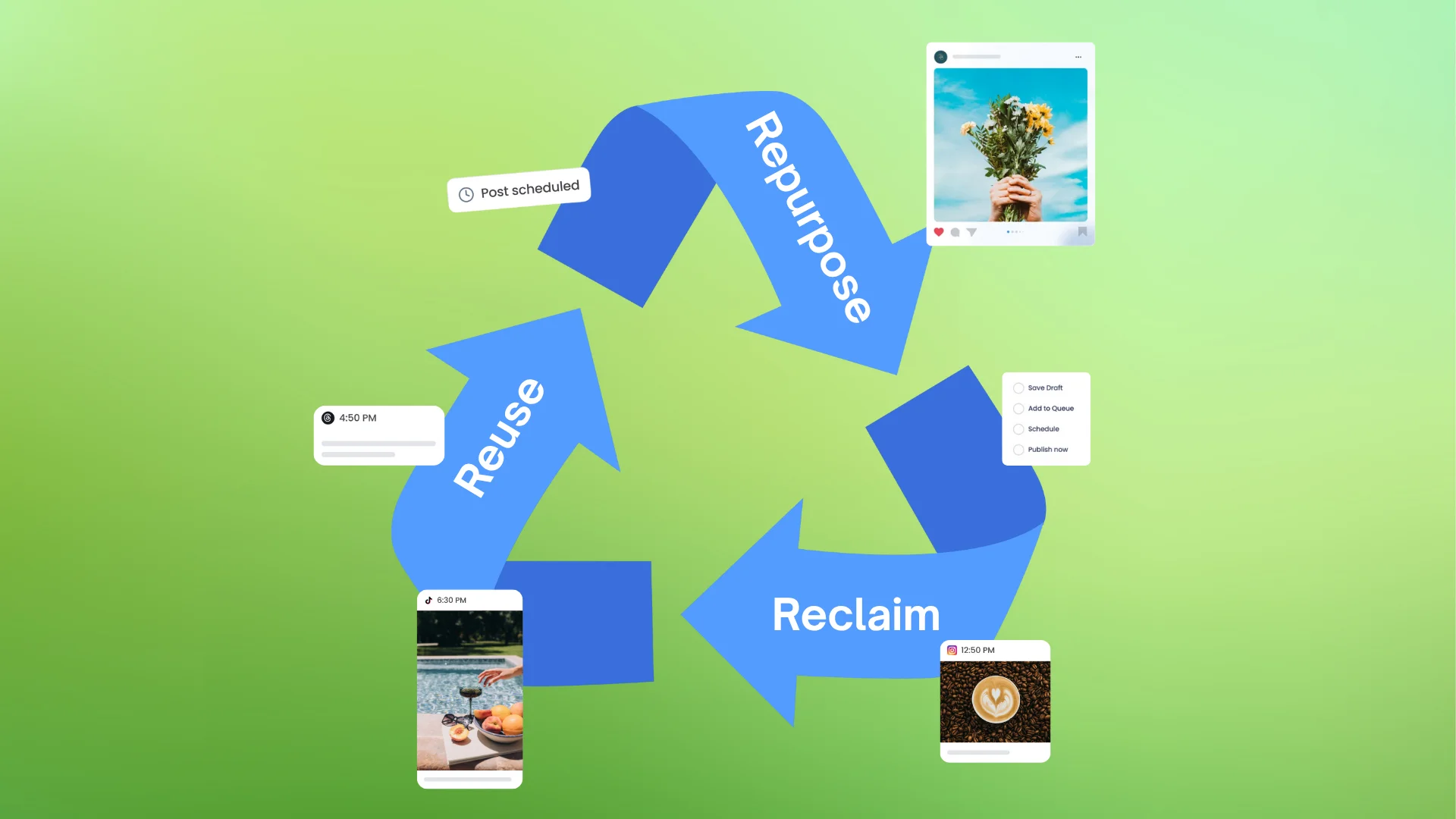
Mastering Content Reuse: The Key to a Consistent and Sustainable Posting Strategy
Published on October 29, 2025
17 min to read
How to Write Social Media Captions That Drive Engagement
Summarize with AI


Table of Content

Your post visuals work to stop the scroll. But your social media captions are what keeps users engaged for even longer.
Many brands still treat captions like afterthoughts. They write basic descriptions and wonder why their posts don’t get engagement. But the brands winning on social media know something important: Great captions don’t just describe content—they start conversations, build communities, and drive real business results.
A good social media caption provides context for the visual, tells a story, and gives viewers an action to take next. But getting that combination right can be tough.
In this guide, you’ll learn exactly how to write captions that get people talking. We’ll cover proven strategies that work across all platforms, plus real examples from brands doing it right.
Table of contents
Why you need to write good social media captions
Social media has changed how people look at content. People spend a significant amount of time scrolling every day. During that time, users make quick decisions about what deserves their attention.
Your caption can help make that decision. A good social media caption is what turns a quick glance into real interest and engagement.
Your caption can provide more value
A good caption provides even more value or context to your social media post. Think of your caption as the bridge between your visual content and how your audience feels about it.
Instagram’s average engagement rate is 0.45%, showing a significant decline from previous years. With less organic reach across platforms, every word in your caption needs to work harder.
Pro tip: Vista Social’s AI assistant helps marketers understand which caption styles work best with their audience. This approach gets rid of guesswork and helps brands focus on what actually drives results.
Your caption can tap into emotions
Successful captions tap into basic human emotions. Fear of missing out, curiosity, humor, inspiration—these triggers make people engage. And building an active social media community is crucial for success.
The most engaging captions create emotional connections by addressing specific problems or wants. When someone sees your content and thinks, “This is exactly what I needed to hear today,” you’ve made an emotional connection.
These connections turn casual followers into loyal brand fans who actively engage with and share your content.
Your caption needs to be platform-specific
Each platform has its own caption culture. LinkedIn users expect professional insights. TikTok thrives on authentic, conversational content. Understanding these differences helps you adapt your voice without losing your brand identity.
The key is keeping your core message consistent while adjusting your style for each platform’s audience. A single piece of content can become multiple platform-specific posts by changing tone and length. This approach maximizes reach while respecting each platform’s unique community standards.
Essential elements of engaging social media captions
Great captions share a few common elements no matter what platform you use. They grab attention right away, tell good stories, and guide readers toward specific actions.
These key elements help you create content that consistently engages your audience across all social media channels.
Hook and opening lines
Your first sentence determines everything. It decides whether someone reads more or keeps scrolling.
Pretty Little Marketer does a great job at immediately grabbing the audience’s attention, starting with “are we OVER engaging? 👀🥱✨🚨” in a world where engagement is seen as the holy grail of social media success.
How can you emulate this?
Craft attention-grabbing first sentences
Start with power. Use strong, specific language that immediately shows value. Instead of, “Today I want to talk about productivity,” try, “This 5-minute morning routine doubled my daily output.”
Numbers, specific outcomes, and real benefits create instant credibility and interest. Your opening sentence should make a promise that the rest of your caption keeps. The more specific and actionable your hook, the more likely your audience is to keep reading.
Spark curiosity by asking questions
Questions work because they create gaps that brains naturally want to fill. Posts with direct community involvement and educational messaging drive higher interaction rates.
Including questions like, “What if I told you…” or, “Ever wonder why…” or even just “How to…” immediately grab the reader’s attention.
A good example of the latter is this reel by Bound Social on Instagram. In the caption, she immediately goes to the point: “How to create the embossed effect in Canva with text or elements.” It also helps that she immediately shows the step-by-step process in her reel.
Try using different types of questions to boost engagement. Ask for opinions (“Which design do you prefer?”), experiences (“What’s your biggest social media challenge?”), or predictions (“Where do you think this trend is heading?”).
Open-ended questions work better than yes/no questions because they encourage longer, more thoughtful responses that boost your post’s visibility in the algorithm.
Make a bold statement
Strong statements drive engagement because they force people to pick sides. The key is being bold without being offensive. Share industry insights that challenge common thinking.
Controversial content works best when it’s backed by data or personal experience rather than just opinion. Take a stance on industry debates, challenge widely accepted practices, or share different viewpoints that your audience hasn’t considered. The goal is to spark meaningful discussion, not create unnecessary conflict.
Use Vista Social’s AI Assistant
Vista Social’s AI assistant can help you create compelling hooks tailored to your brand voice and audience. Head to your Vista Social settings to create your brand voice so the AI assistant can consistently use the same style for all of your captions.
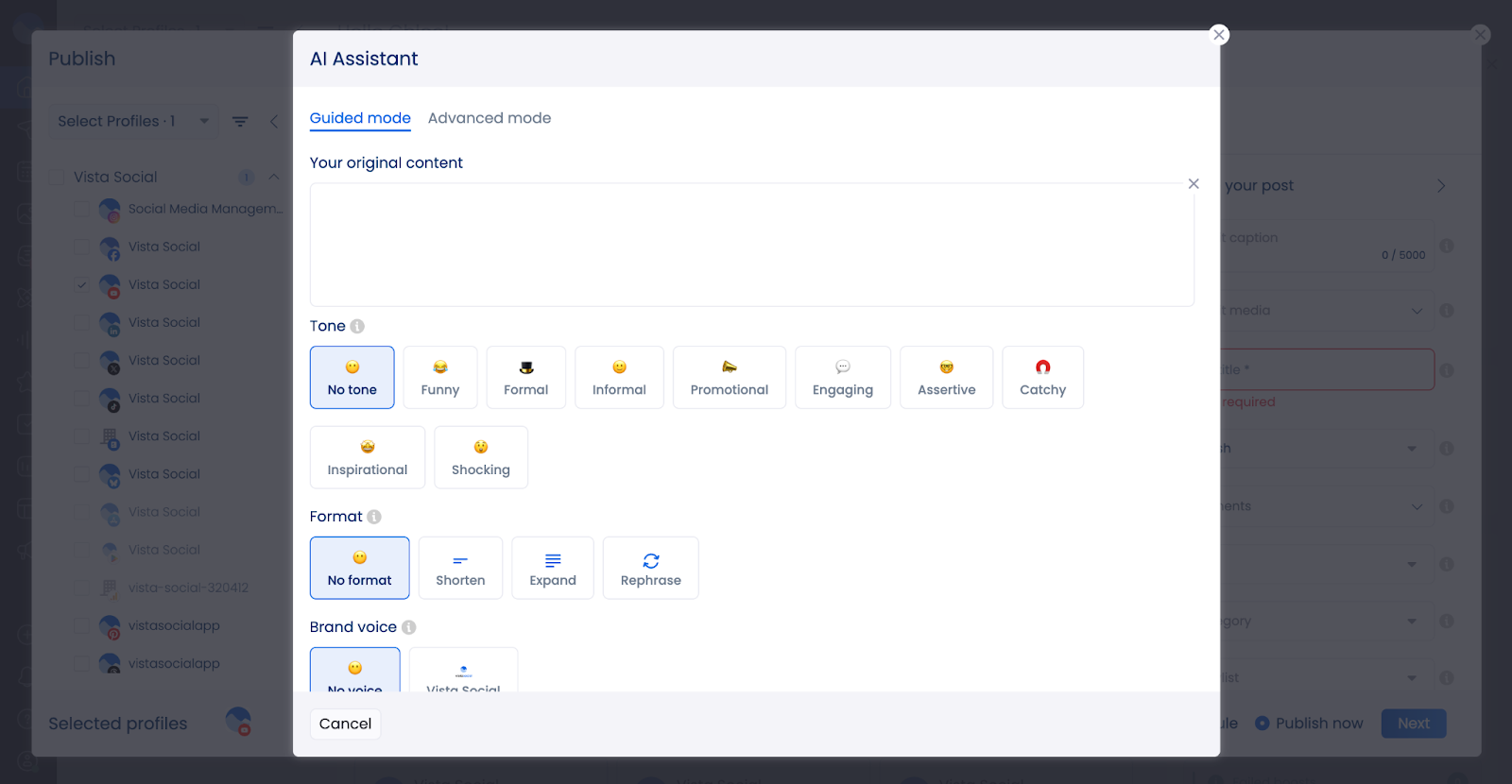
You can take advantage of Guided mode, which helps you set up your prompt, or use the Advanced mode to input exactly what you’re hoping to create.
Storytelling
Humans love stories. Stories create emotional connections that facts alone can’t match. Good stories turn boring product updates into compelling content that audiences remember and share.
A good example would be Storytale, whose entire brand revolves around why and how telling your own story can make your business stand out from the crowd.
They cleverly use storytelling as a way to draw their audience in, painting a clear picture of what pain point they’re targeting, and how—if applied correctly in marketing—storytelling can transform boring product descriptions into engaging narratives that customers actually want to read and share.
Create a narrative
Structure your captions like mini-stories with clear beginnings, middles, and ends. Use the problem-solution framework (start with a challenge your audience faces, then reveal how your product or service solves it) or the before-and-after structure (show the situation before using your solution, then highlight the positive transformation afterward). Even product announcements become more engaging when framed as stories.
The most effective social media stories focus on conflict and resolution. This creates tension that keeps readers engaged until the end. Start with a relatable challenge, build suspense around the struggle, then reveal the solution or outcome. This story arc works whether you’re sharing customer success stories, behind-the-scenes content, or educational insights.
Share personal anecdotes
Personal stories from team members humanize your brand and build trust. Share failures alongside successes. Vulnerability creates deeper connections than perfection ever will.
Brand stories work best when they focus on impact and values rather than achievements alone. Show how your company’s decisions affect real people, highlight the human element behind business choices, and demonstrate your commitment to your community. Personal stories from founders, employees, or customers add authenticity that generic brand messaging can’t match.
Create relatable content
Focus on universal experiences your audience shares. The morning coffee ritual, the Sunday planning session, the post-workout exhaustion—these moments create instant recognition and connection.
Relatable content works because it makes your audience feel seen and understood. When people recognize their own experiences in your stories, they’re more likely to engage with your post, leaving a comment or sharing it with others who might also relate.
The key is identifying the common threads that connect your diverse audience members and weaving those themes throughout your storytelling.
Call-to-actions
Every caption should guide readers toward a specific next step. This could be commenting, sharing, or clicking through to your website. Good calls-to-action turn passive content consumption into active community participation and business growth.
An example of a good CTA is this post from Patagonia. Simple and clear, it tells its audience to go to their link in bio to learn more about their Nano Puff® jacket redesign and make a purchase if interested.
Use your CTA to drive action
The most effective CTAs feel natural and valuable. Instead of, “Link in bio,” try, “Get the complete checklist that helped 10,000+ marketers streamline their workflows (link in bio).”
Value-driven CTAs work because they clearly communicate what the reader will gain by taking action. Specific benefits, social proof, and urgency create compelling reasons to engage.
The best CTAs feel like helpful recommendations from a trusted friend rather than pushy sales tactics.
Cater your CTA to each platform
Understanding each platform’s culture is crucial for CTA success.
Twitter users respond to conversation starters and retweet requests, while Facebook audiences engage with longer-form questions that encourage detailed responses.
TikTok thrives on participation CTAs like, “Try this and tell me how it goes,” that encourage user-generated content and trend participation. Instagram benefits from community-building CTAs like, “Tag someone who needs this.”
And finally, LinkedIn responds well to professional development prompts like, “What’s your experience with this approach?”
Vista Social’s content planning tools help you customize CTAs for each platform while maintaining message consistency.
Balance promotional and engaging CTAs
Follow the 80/20 rule: 80% of your CTAs should focus on community building and value delivery, while 20% can be directly promotional.
This balance maintains audience trust while still driving business results. Non-promotional CTAs build relationship capital that makes your occasional promotional asks more effective. When you do promote products or services, frame the CTA around customer benefits rather than company needs to maintain the value-first approach your audience expects.
How to write great social media captions: Platform-by-platform
Each social media platform has developed its own caption ecosystem with unique best practices and audience expectations. Understanding these platform-specific differences helps you maximize engagement while maintaining brand consistency across channels.
How to write Instagram captions
Instagram gives you the most flexibility for caption creativity, with up to 2,200 characters to work with. This generous character limit allows for detailed storytelling, comprehensive value delivery, and creative expression that other platforms don’t accommodate.
Optimal length and formatting
Instagram caption length is currently capped at 2,200 characters. However, length isn’t everything—engagement depends more on value than word count. Use line breaks and emojis to improve readability (but be sure to keep social media accessibility in mind as screen readers have a tough time reading out too many emojis).
Visual formatting significantly impacts caption performance on Instagram. Strategic use of white space, bullet points, and clear section breaks help readers scan your content quickly.
The first few lines are crucial since Instagram truncates captions in the feed, so front-load your most compelling content to encourage users to tap “more.”
Hashtag strategies
Use 5-10 targeted hashtags (Instagram penalizes spammy overuse). Mix broad and niche hashtags for better reach. Place hashtags strategically, either integrated naturally within your caption or grouped at the end.
Research your hashtags before using them to ensure they align with your content and audience. Tools like Instagram’s search function show you how many posts use each hashtag and what type of content performs well.
Avoid hashtags that are too broad (like #love or #happy) as your content will get lost, and stay away from hashtags that are too niche if you want meaningful reach.
Instagram caption optimization with Vista Social
Vista Social streamlines Instagram caption creation with built-in tools like the AI Assistant, our hashtag suggestions, and scheduling capabilities.
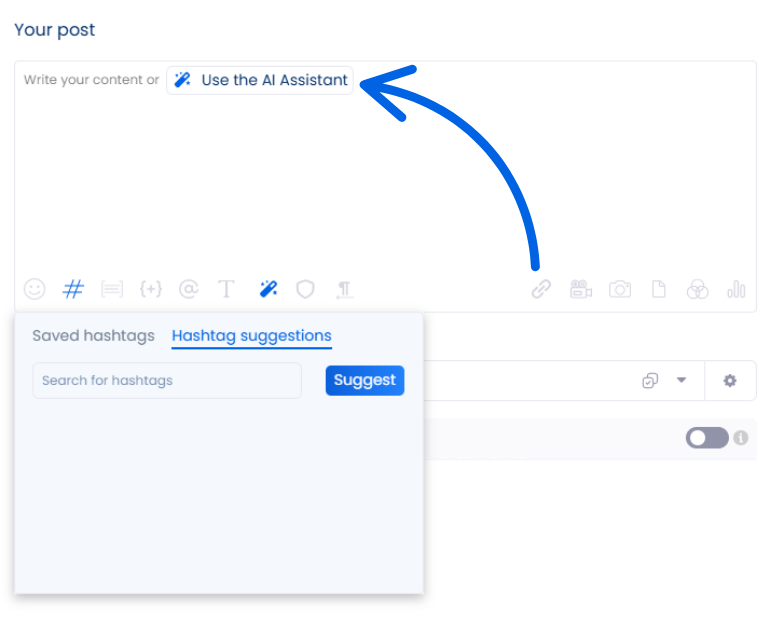
The platform’s Instagram-specific features help you maintain visual consistency while varying your caption approach. You can save high-performing caption templates, test different posting times, and track engagement patterns to refine your strategy.
Vista Social’s unified dashboard makes it easy to manage multiple Instagram accounts while maintaining each one’s unique voice and style.
Instagram caption example
This post from a Vista Social user works because the caption tells a clear before-and-after story. It starts with a problem most content creators face—feeling overwhelmed by posting. Then it shows how Vista Social solved that problem.
The checkmarks make the benefits easy to scan, and the casual tone feels real. The call-to-action is simple and clear. This also shows how to tell a story, highlight your product, and get people to engage in just a few sentences.
How to write Facebook captions
Facebook’s algorithm favors posts that generate meaningful conversations, making caption strategy crucial for organic reach. The platform’s mature user base and emphasis on community building create unique opportunities for deeper, more substantial content.
Longer-form content opportunities
Facebook users engage with longer content more than other platforms. Use this space to dive deeper into topics, sharing detailed insights and creating valuable content.
Try Vista Social for Free
A social media management platform that actually helps you grow with easy-to-use content planning, scheduling, engagement and analytics tools.
Get Started NowThe platform’s algorithm rewards content that keeps users engaged and starts meaningful discussions. Longer captions work well when they provide educational value, tell complete stories, or offer detailed analysis.
Don’t be afraid to write substantial captions that thoroughly explore topics your audience cares about. Facebook users will read them if the content is valuable.
Community building
Ask thoughtful questions that need more than yes/no answers. Create discussion prompts that encourage followers to share their experiences and insights.
Facebook’s community-focused culture makes it ideal for building genuine relationships with your audience. Use captions to help community members meet each other. Highlight customer stories and create opportunities for peer-to-peer learning. The goal is to position yourself as a community facilitator rather than just a content broadcaster.
Facebook caption example
This Vista Social caption works because it opens with a competitive hook that creates urgency. It provides specific, actionable advice rather than generic tips, and clearly connects small daily habits to bigger business results. The simple call-to-action drives readers to learn more, while the visual reinforces the step-by-step growth message.
How to write LinkedIn captions
LinkedIn’s professional environment needs a more strategic caption approach. Focus on industry insights and thought leadership. The platform’s business audience expects valuable, actionable content that helps their professional development and industry knowledge.
Thought leadership
Share industry observations, lessons learned, and forward-thinking perspectives. Position yourself as a valuable resource for your network’s professional development.
Effective thought leadership captions combine personal experience with broader industry insights to create content that’s both authoritative and relatable. Don’t just share opinions—back them up with data, examples, or case studies that demonstrate your expertise.
The best LinkedIn captions spark professional discussions that add value to everyone involved in the conversation.
Professional storytelling
Frame personal experiences as universal business lessons. Connect individual challenges to broader industry trends and solutions.
The most engaging LinkedIn stories balance personal vulnerability with professional insight. Share specific challenges you’ve faced, the strategies you used to overcome them, and the lessons others can apply to their own situations.
This approach builds credibility while providing actionable value that your network can use immediately.
Industry-specific approaches
Tailor your language and topics to your industry while staying authentic. B2B audiences like data-driven insights. Creative industries respond to innovation and inspiration stories.
Understanding your industry’s communication norms helps you create content that works with your professional community. Use industry terms appropriately and reference relevant challenges. Share insights that show your deep understanding of your field’s specific issues.
The goal is to establish yourself as someone who truly understands your field’s unique dynamics and challenges.
LinkedIn caption example
This caption from Amazon works because it puts creators at the center instead of sounding like an advertisement. It uses real success stories from different countries and creative industries, which makes the message more believable and inspiring.
The writing is easy to scan, emotionally uplifting, and shows both cultural and economic impact without being too sales-heavy. By focusing on global reach, creativity, and real achievements, it connects with audiences, motivates other creators, and reinforces Amazon’s role without sounding pushy.
How to write X/Twitter captions
X/Twitter’s 280-character limit (unless you’re a paid subscriber) forces concise, punchy communication that cuts straight to the point. This constraint creates opportunities for sharp wit, timely commentary, and memorable one-liners that can achieve massive reach through retweets and engagement.
Maximizing limited character counts
Every word must earn its place. Use strong verbs, eliminate unnecessary words, and prioritize clarity over cleverness.
Character constraints force you to distill your message to its essence, which often makes your content more impactful. Focus on one clear idea per tweet, use active voice to save characters, and leverage abbreviations and symbols where appropriate.
The goal is maximum impact with minimum words—a skill that improves all your caption writing across platforms.
Thread strategies
Use threads—a series of connected tweets—to tell longer stories while keeping each tweet engaging on its own. Start threads with compelling hooks that encourage users to click “Show this thread.”
Each tweet in your thread should provide value independently while contributing to the larger narrative. Number your tweets (1/7, 2/7, etc.) to help readers follow along, and end with a clear conclusion or call-to-action.
Threads allow you to combine Twitter’s immediacy with longer-form storytelling, creating content that’s both shareable and substantial.
Trending topic integration
Join relevant conversations by incorporating trending hashtags and topics. Add unique value to popular discussions rather than simply echoing what others say.
Monitor trending topics regularly. Look for opportunities that align with your brand voice and expertise. When you join trending conversations, bring fresh perspectives. Bring data or insights that advance the discussion.
With this tactic, you want to contribute meaningfully to existing conversations. Also, introduce your brand to new audiences who might not have discovered you otherwise.
X/Twitter caption example
This Wendy’s caption works because it takes a trending TV moment and turns it into relatable, everyday humor. The casual language (“angie’s 1.5 salons”) feels authentic and makes the brand seem like a real person joining the conversation.
It’s also completely in brand as the team behind Wendy’s X/Twitter account is known to take jabs at their audience and stay trendy.
Canceling my hair appointment at angie’s 1.5 salons https://t.co/9IB7oBIFbr
— Tendy’s (@Wendys) October 8, 2025
Best practices for writing social media captions
Mastering caption writing requires understanding both technical best practices and emotional psychology. The most successful social media managers combine data-driven strategies with authentic human connection to create content that truly resonates.
Use humor effectively
Humor builds instant connections but requires careful calibration. Self-deprecating humor often works better than humor at others’ expense. Test different humor styles to find what resonates with your audience.
The key to successful humor in social media captions is understanding your audience’s sensibilities and current mood. What’s funny in one context might fall flat in another, so pay attention to timing, cultural sensitivity, and appropriateness for your brand voice. When humor works, it creates memorable content that people love to share with their networks.
This Ritz Crackers post shows just how well humor can work in this Threads post below.
View on Threads
Inspire and motivate your audience
Share victories, both big and small. Celebrate progress, acknowledge struggles, and offer encouragement. Motivational content performs well when it feels authentic rather than generic.
The most effective motivational captions connect inspiration to specific, actionable steps your audience can take. Rather than generic positivity, offer concrete encouragement related to challenges your community actually faces. Personal stories of overcoming obstacles resonate more than abstract motivational quotes because they feel real and achievable.
An example of this is Jeanie Ahn on Instagram. This specific post works as motivation because Jeanie shows a real person achieving a goal that many creators want. Instead of just celebrating, she promises to share the lessons she learned along the way.
The honest mention of “not losing my soul” makes it feel authentic rather than like a humble brag. By welcoming new followers and promising helpful insights, she turns her personal win into value for her community.
Handle sensitive topics appropriately
When addressing challenging topics, lead with empathy and provide constructive perspectives. Avoid taking political stances unless they’re directly relevant to your brand mission.
Sensitive topics require extra care in both language choice and timing. Focus on shared human experiences rather than divisive issues, and always consider how your words might affect different members of your community. When in doubt, err on the side of compassion and inclusivity while staying true to your brand values.
Match captions to visual content
Strong captions either complement visuals by providing context or create contrasts that spark curiosity. Your caption and visual should connect on purpose, not by accident. Complementary captions work well for tutorials, product showcases, and educational content.
Here, context helps understanding. Contrasting captions create intrigue. They encourage deeper engagement by adding unexpected meaning to familiar visuals.
Chloe Shih has always made great work with matching her captions to her visual content—her videos, in this case. Instead of generic business advice, Chloe shares specific insights from her actual experience at Amazon Accelerate. The video clips also prove she was really there, which makes her takeaways feel more credible.
Consider accessibility needs
Write captions that provide value even when visuals can’t be seen. This improves accessibility. It also ensures your message reaches everyone in your community.
Accessible caption writing benefits everyone, not just users with visual impairments. Clear, descriptive captions help when images fail to load. They help when data is limited. They help when users are in environments where they can’t focus on visuals.
Think about how your caption would work as standalone content. If it provides complete value on its own, you’ve achieved good accessibility.
Top tools for writing engaging social media captions
The right tools make caption creation easier without sacrificing authenticity or creativity. Modern social media management requires balancing efficiency with genuine human connection. This makes tool selection crucial for lasting success.
Vista Social’s AI assistant
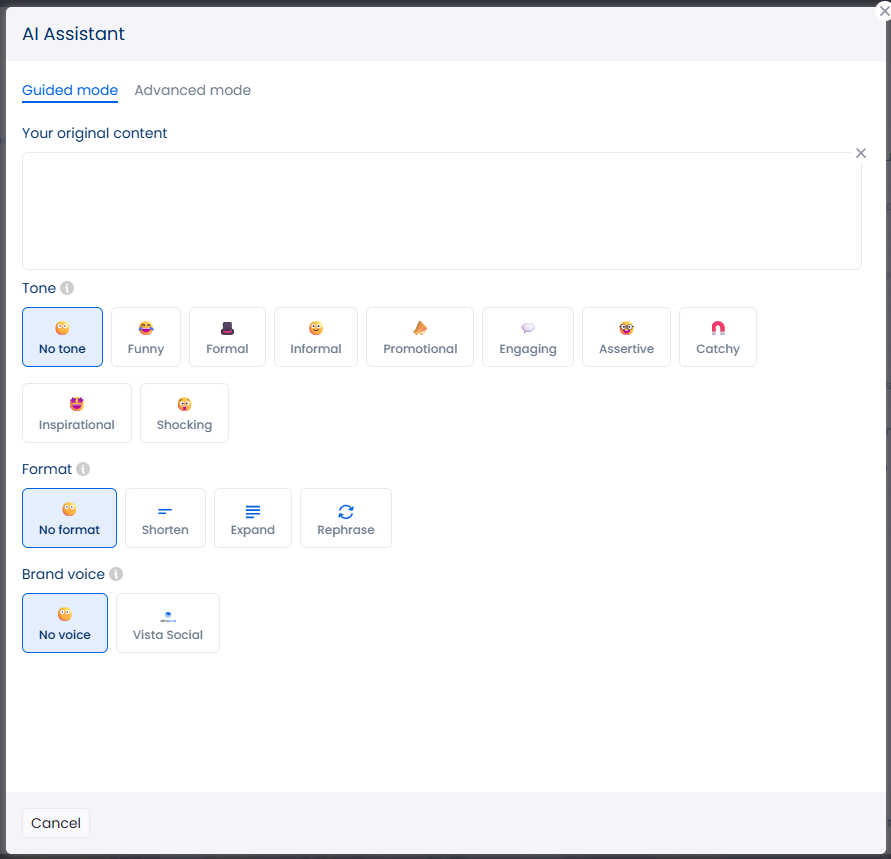
Vista Social puts ChatGPT-powered AI directly into the content creation workflow. The AI assistant learns your brand voice. It analyzes your top-performing content. It creates captions that match your established style and audience preferences.
The platform’s AI goes beyond basic caption generation. It uses your past performance data and brand guidelines. This means suggestions become more targeted and effective over time. It helps you stay consistent while finding new approaches that work with your specific audience.
The smooth integration means you don’t need to switch between multiple tools during content creation.
Vista Social’s free caption generator
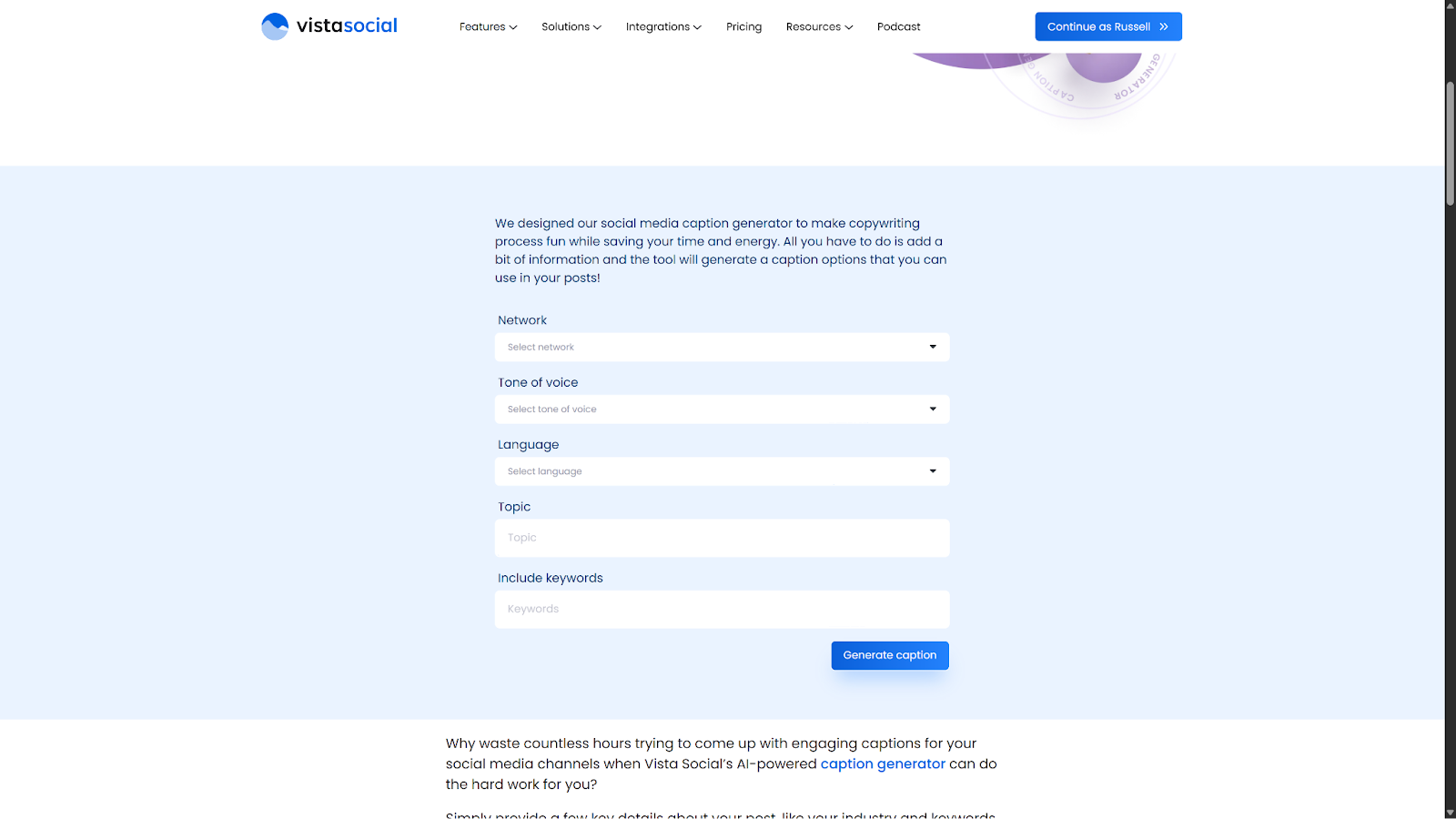
Vista Social’s free caption generator gives instant caption suggestions across all major platforms. The tool considers platform-specific best practices and audience behavior patterns.
This accessible tool makes professional-quality caption creation available to everyone. It provides valuable suggestions regardless of budget constraints.
The generator’s platform-aware approach ensures your captions align with each social network’s unique culture and formatting requirements. It’s a great starting point for businesses just beginning to develop their social media voice.
Common mistakes to avoid when writing social media captions
Understanding what doesn’t work is just as important as knowing what does. Many caption failures come from predictable mistakes that you can easily avoid with awareness and simple prevention strategies.
Overly promotional content
Instead of only posting promotional content, brands should use formats that engage their audience. Focus on giving value first, building relationships second, and promoting products third.
Audiences can immediately tell when brands care more about selling than helping. They respond by unfollowing, ignoring, or avoiding promotional content. The most successful social media strategies hide promotional messages inside valuable content.
This makes offers feel like helpful tips rather than sales pitches. Build trust by consistently giving value, then use that trust for occasional promotional posts.
Inconsistent brand voice
Your audience should recognize your content immediately, even without seeing your username. Develop clear voice guidelines and stick to them across all platforms and team members.
Being inconsistent confuses your audience and weakens brand recognition. This makes it harder to build the familiarity that drives engagement. Create detailed brand voice guides that cover tone, word choices, humor style, and how to express values. Train all team members on these guidelines and set up review processes to catch voice problems before content goes live.
Ignoring platform-specific best practices
What works on LinkedIn won’t necessarily work on TikTok. Respect each platform’s unique culture and user expectations while maintaining your brand identity.
Using the same approach on every platform often fails because users think differently on each social network. LinkedIn users want professional content, while Instagram users want visual inspiration and fun content. Change your main message to fit each platform’s style while keeping your brand values and personality the same across all channels.
Poor grammar and spelling
Basic errors undermine credibility and distract from your message. Use proofreading tools and establish review processes to catch mistakes before publication.
Even though social media is more casual than formal writing, basic mistakes still hurt your credibility. Simple errors can make good content look unprofessional and unreliable. Use editing tools, make proofreading checklists, and have team members check each other’s work before posting.
Writing better social media captions: Your next steps
Good social media captions need to do two things: grab attention and get people to act. The best captions start strong, tell stories, give value, and end with a clear call to action. They sound like real conversations but still look professional.
To get better at writing captions, you need to understand what works on each platform. Try varying lengths, test different ideas to discover what works, and change your approach based on your results.
Vista Social turns caption writing from guesswork into smart strategy. Our AI tools help create good content while data shows what works with your audience. Create high-quality captions with our AI assistant, schedule your posts with ease, and monitor performance all in one place.
About the Author
Content Writer
Russell Tan is a content marketing specialist with over 7 years of experience creating content across gaming, healthcare, outdoor hospitality, and travel—because sticking to just one industry would’ve been boring. Outside of her current role as marketing specialist for Vista Social, Russell is busy plotting epic action-fantasy worlds, chasing adrenaline rushes (skydiving is next, maybe?), or racking up way too many hours in her favorite games.
Read with AI
Save time reading this article using your favorite AI tool
Summarize with AI
Never Miss a Trend
Our newsletter is packed with the hottest posts and latest news in social media.
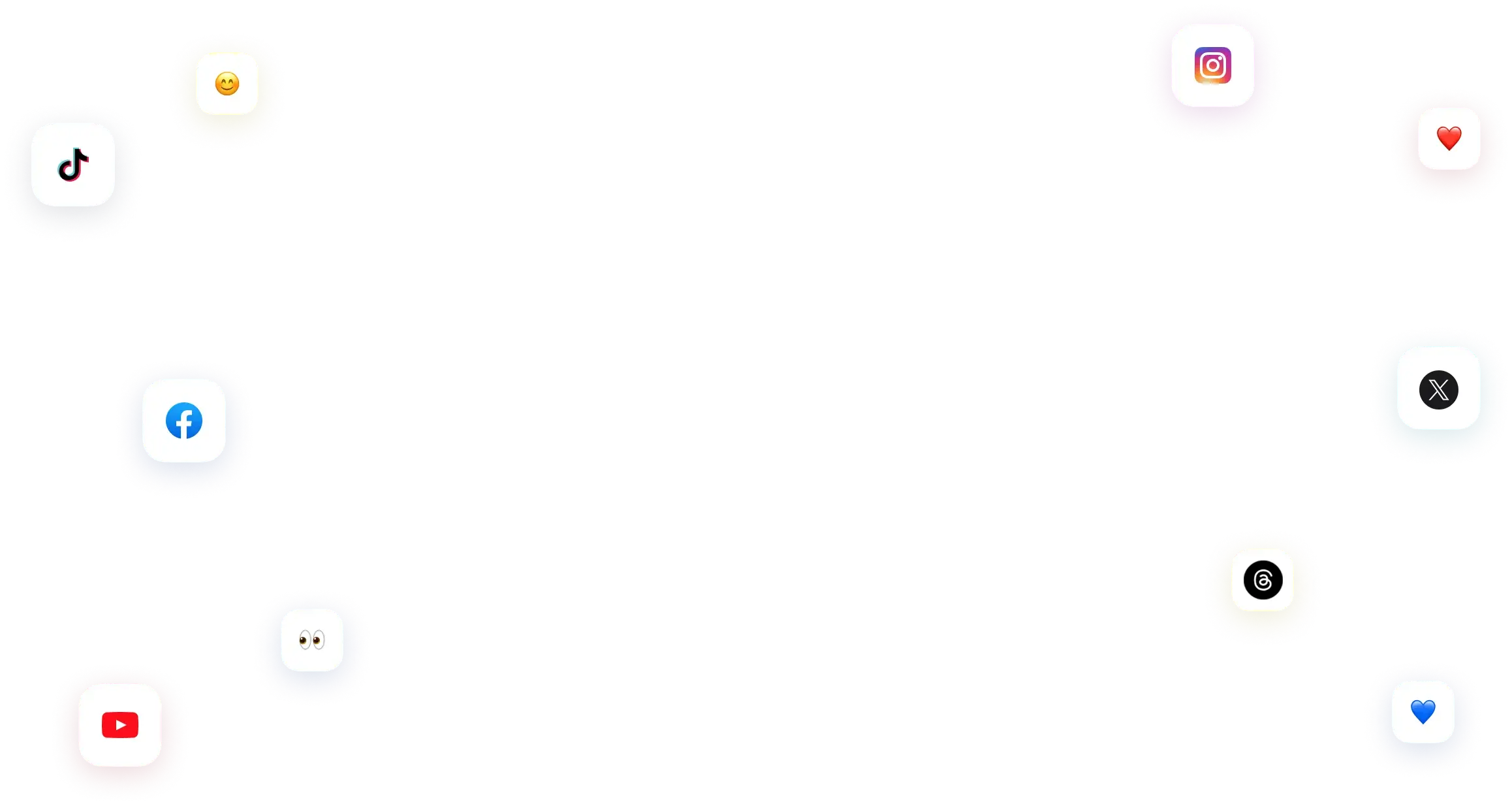
You have many things to do.
Let us help you with social media.
Use our free plan to build momentum for your social media presence.
Or skip ahead and try our paid plan to scale your social media efforts.
P.S. It will be a piece of cake 🍰 with Vista Social
Subscribe to our Newsletter!
To stay updated on the latest and greatest Social Media news. We promise not to spam you!


